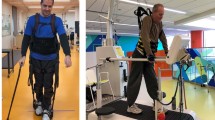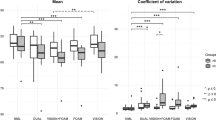Abstract
Study design
Prospective quasi-experimental study, pre- and post-design.
Objectives
Assess safety, feasibility, training characteristics and changes in gait function for persons with spinal cord injury (SCI) using the robotic exoskeletons from Ekso Bionics.
Setting
Nine European rehabilitation centres.
Methods
Robotic exoskeleton gait training, three times weekly over 8 weeks. Time upright, time walking and steps in the device (training characteristics) were recorded longitudinally. Gait and neurological function were measured by 10 Metre Walk Test (10 MWT), Timed Up and Go (TUG), Berg Balance Scale (BBS), Walking Index for Spinal Cord Injury (WISCI) II and Lower Extremity Motor Score (LEMS).
Results
Fifty-two participants completed the training protocol. Median age: 35.8 years (IQR 27.5–52.5), men/women: N = 36/16, neurological level of injury: C1-L2 and severity: AIS A–D (American Spinal Injury Association Impairment Scale). Time since injury (TSI) < 1 year, N = 25; > 1 year, N = 27.
No serious adverse events occurred. Three participants dropped out following ankle swelling (overuse injury). Four participants sustained a Category II pressure ulcer at contact points with the device but completed the study and skin normalized. Training characteristics increased significantly for all subgroups. The number of participants with TSI < 1 year and gait function increased from 20 to 56% (P = 0.004) and 10MWT, TUG, BBS and LEMS results improved (P < 0.05). The number of participants with TSI > 1 year and gait function, increased from 41 to 44% and TUG and BBS results improved (P < 0.05).
Conclusions
Exoskeleton training was generally safe and feasible in a heterogeneous sample of persons with SCI. Results indicate potential benefits on gait function and balance.
Similar content being viewed by others
Login or create a free account to read this content
Gain free access to this article, as well as selected content from this journal and more on nature.com
or
References
Kirshblum SC, Priebe MM, Ho CH, Scelza WM, Chiodo AE, Wuermser L-A. Spinal Cord Injury Medicine. 3. Rehabilitation Phase After Acute Spinal Cord Injury. Arch Phys Med Rehabil. 2007;88:S62–70.
Ditunno PL, Patrick M, Stineman M, Ditunno JF. Who wants to walk? Preferences for recovery after SCI: a longitudinal and cross-sectional study. Spinal Cord. 2008;46:500–6.
Burns SP, Golding DG, Rolle WA, Graziani V, Ditunno JF. Recovery of ambulation in motor-incomplete tetraplegia. Arch Phys Med Rehabil. 1997;78:1169–72.
Mehrholz J, Kugler J, Pohl M. Locomotor training for walking after spinal cord injury. Cochrane Database Syst Rev. 2012;11:CD006676.
Waters RL, Yakura JS, Adkins RH, Sie I. Recovery following complete paraplegia. Arch Phys Med Rehabil. 1992;73:784–9.
Van Kammen K, Boonstra A, Reinders-Messelink H, den Otter R. The Combined Effects of Body Weight Support and Gait Speed on Gait Related Muscle Activity: A Comparison between Walking in the Lokomat Exoskeleton and Regular Treadmill Walking. PLoS ONE. 2014;9:e107323.
Stamatakis E, Rogers K, Ding D, Berrigan D, Chau J, Hamer M, et al. All-cause mortality effects of replacing sedentary time with physical activity and sleeping using an isotemporal substitution model: a prospective study of 201,129 mid-aged and older adults. Int J Behav Nutr Phys Acta. 2015;12:121.
Kozlowski AJ, Bryce TN, Dijkers MP. Time and effort required by persons with spinal cord injury to learn to use a powered exoskeleton for assisted walking. Top Spinal Cord Inj Rehabil. 2015;21:110–21.
Zeilig G, Weingarden H, Zwecker M, Dudkiewicz I, Bloch A, Esquenazi A. Safety and tolerance of the ReWalk exoskeleton suit for ambulation by people with complete spinal cord injury: a pilot study. J Spinal Cord Med. 2012;35:96–101.
Kolakowsky-Hayner SA. Safety and Feasibility of using the EksoTM Bionic Exoskeleton to Aid Ambulation after Spinal Cord Injury. J Spine 2013. https://doi.org/10.4172/2165-7939.S4-003
Esquenazi A, Talaty M, Packel A, Saulino M. The ReWalk powered exoskeleton to restore ambulatory function to individuals with thoracic-level motor-complete spinal cord injury. Am J Phys Med Rehabil Assoc Acad Physiatr. 2012;91:911–21.
Miller LE, Zimmermann AK, Herbert WG. Clinical effectiveness and safety of powered exoskeleton-assisted walking in patients with spinal cord injury: systematic review with meta-analysis. Med Devices Auckl NZ. 2016;9:455–66.
Sale P, Russo EF, Russo M, Masiero S, Piccione F, Calabrò RS, et al. Effects on mobility training and de-adaptations in subjects with Spinal Cord Injury due to a Wearable Robot: a preliminary report. BMC Neurol. 2016;16:12.
Kressler J, Thomas CK, Field-Fote EC, Sanchez J, Widerström-Noga E, Cilien DC, et al. Understanding Therapeutic Benefits of Overground Bionic Ambulation: Exploratory Case Series in Persons With Chronic, Complete Spinal Cord Injury. Arch Phys Med Rehabil. 2014;95:1878–87.
Borg GA. Psychophysical bases of perceived exertion. Med Sci Sports Exerc. 1982;14:377–81.
Anon. Perceived Exertion (Borg Rating of Perceived Exertion Scale) | Physical Activity | CDC. https://www.cdc.gov/physicalactivity/basics/measuring/exertion.htm (accessed 26 Apr2017).
National Pressure Ulcer Advisory Panel, European Pressure Ulcer Advisory Panel and Pan Pacific Pressure Injury Alliance. Prevention and Treatment of Pressure Ulcers: Quick Reference Guide. Emily Haesler. Osborne Park, Western Australia: Cambridge Media; 2014. Available at: http://www.npuap.org/wp-content/uploads/2014/08/Quick-Reference-Guide-DIGITAL-NPUAP-EPUAP-PPPIA-Jan2016.pdf (accessed on 15 Aug 2016).
Kirshblum SC, Burns SP, Biering-Sorensen F, Donovan W, Graves DE, Jha A, et al. International standards for neurological classification of spinal cord injury (revised 2011). J Spinal Cord Med. 2011;34:535–46.
Itzkovich M, Gelernter I, Biering-Sorensen F, Weeks C, Laramee MT, Craven BC, et al. The Spinal Cord Independence Measure (SCIM) version III: reliability and validity in a multi-center international study. Disabil Rehabil. 2007;29:1926–33.
Alexander MS, Anderson K, Biering-Sorensen F, Blight AR, Brannon R, Bryce T, et al. Outcome Measures in Spinal Cord Injury. Spinal Cord. 2009;47:582–91.
Marino RJ, Graves DE. Metric properties of the ASIA motor score: subscales improve correlation with functional activities. Arch Phys Med Rehabil. 2004;85:1804–10.
Poncumhak P, Saengsuwan J, Kamruecha W, Amatachaya S. Reliability and validity of three functional tests in ambulatory patients with spinal cord injury. Spinal Cord. 2013;51:214–7.
van Hedel HJ, Wirz M, Dietz V. Assessing walking ability in subjects with spinal cord injury: validity and reliability of 3 walking tests. Arch Phys Med Rehabil. 2005;86:190–6.
Jackson AB, Carnel CT, Ditunno JF, Read MS, Boninger ML, Schmeler MR, et al. Outcome measures for gait and ambulation in the spinal cord injury population. J Spinal Cord Med. 2008;31:487–99.
Wirz M, Müller R, Bastiaenen C. Falls in persons with spinal cord injury: validity and reliability of the Berg Balance Scale. Neurorehabil Neural Repair. 2010;24:70–7.
Lemay J-F, Nadeau S. Standing balance assessment in ASIA D paraplegic and tetraplegic participants: concurrent validity of the Berg Balance Scale. Spinal Cord. 2010;48:245–50.
Benson I, Hart K, Tussler D, Middendorp van JJ. Lower-limb exoskeletons for individuals with chronic spinal cord injury: findings from a feasibility study. Clin Rehabil. 2016;30:73–84.
Bernardi M, Canale I, Castellano V, Di Filippo L, Felici F, Marchetti M. The efficiency of walking of paraplegic patients using a reciprocating gait orthosis. Paraplegia. 1995;33:409–15.
Sykes L, Edwards J, Powell ES, Ross ER. The reciprocating gait orthosis: long-term usage patterns. Arch Phys Med Rehabil. 1995;76:779–83.
Lewis JE, Nash MS, Hamm LF, Martins SC, Groah SL. The relationship between perceived exertion and physiologic indicators of stress during graded arm exercise in persons with spinal cord injuries. Arch Phys Med Rehabil. 2007;88:1205–11.
Waters RL, Adkins RH, Yakura JS, Sie I. Motor and sensory recovery following incomplete tetraplegia. Arch Phys Med Rehabil. 1994;75:306–11.
Aach M, Cruciger O, Sczesny-Kaiser M, Höffken O, Meindl RC, Tegenthoff M, et al. Voluntary driven exoskeleton as a new tool for rehabilitation in chronic spinal cord injury: a pilot study. Spine J Off J North Am Spine Soc. 2014;14:2847–53.
Wirz M, Zemon DH, Rupp R, Scheel A, Colombo G, Dietz V, et al. Effectiveness of automated locomotor training in patients with chronic incomplete spinal cord injury: A multicenter trial. Arch Phys Med Rehabil. 2005;86:672–80.
Lam T, Noonan VK, Eng JJ. A systematic review of functional ambulation outcome measures in spinal cord injury. Spinal Cord. 2008;46:246–54.
Wu X, Liu J, Tanadini LG, Lammertse DP, Blight AR, Kramer JLK, et al. Challenges for defining minimal clinically important difference (MCID) after spinal cord injury. Spinal Cord. 2015;53:84–91.
Ijzerman MJ, Baardman G, Hermens HJ, Veltink PH, Boom HBK, Zilvold G. Comparative trials on hybrid walking systems for people with paraplegia: An analysis of study methodology. Prosthet Orthot Int. 1999;23:260–73.
Acknowledgements
We thank Linda Jones, PT, MS, Consultant, for writing the initial protocol. We would also like to thank all participants with SCI for being part of the study and to express our gratitude to the following therapists who took part in the training protocol and data collection:Mette Skov Henriksen and Mats Christer Nilfyr (Clinic for Spinal Cord Injuries, Rigshospitalet, University of Copenhagen, Hornbaek, Denmark); Michael Baumberger and Ines Bersch-Porada (Swiss Paraplegic Centre (SPC), Nottwil, Switzerland); Sebastian Stallasch and Sebastian Lux (Universitäts- und Rehabilitationskliniken (RKU), Ulm, Germany); Esperanza Moreno and German Novillo (Fundación Lesionado Medular (FLM), Madrid, Spain); Niklas Fransson, Anna-Karin Hansson, Anna Granström and Mikael Lundgren (Clinical Department of Rehabilitation Medicine at Linköping University Hospital, Jönköping hospital and Västervik hospital, Sweden); Margareta Arnell and Peter Svensson (Spinal Cord Rehabilitation Unit, Uppsala University Hospital, Sweden); Ole Christian Andersen, Anna-Beth Netteland, Trygve Danielsen, Gyri S. Ingebretsen (Sunnaas Sykehus HF, Oslo, Norway); Eloy Opisso, Raquel Lopez, Josep Medina, Manel Ochoa and Eva Morales (Institut Guttmann, Neurorehabilitation Hospital, Barcelona, Spain); David Gobets, Mark van de Mijll Dekker, Ruth Sijsma (Heliomare Rehabilitation Center, Wijk aan Zee, The Netherlands). All authors were supported by their institutions’ internal funds. Ekso Bionics™ provided an unconditional grant for protocol writing, salary for the clinical study lead, and expenses related to the shared database to compile data across the nine centres.
Funding
Each centre was funded independently by grants or internal funds required for data collection on site. Department of Rehabilitation Medicine and Department of Medical and Health Sciences, Linköping University, Linköping, Sweden were funded by Stiftelsen Promobilia, Region Östergötland and Medical Research Council of Southeast Sweden. Spinal Cord Rehabilitation Unit, Uppsala University Hospital, Sweden was funded by Uppsala University Hospital ALF funds. Sunnaas Rehabilitation Hospital, Nesoddtangen, Norway was funded by Sunnaas Stiftelsen (The Sunnaas Foundation). Remaining centres were funded by internal funds. Ekso Bionics provided an unconditional grant for protocol writing, salary for the clinical study lead, and expenses related to the shared database to compile data across the nine centres.
Author information
Authors and Affiliations
Corresponding author
Ethics declarations
Conflict of interest
The authors declare that they have no competing interests.
Additional information
Shared first authorship
Carsten Bach Baunsgaard and Ulla Vig Nissen contributed equally to this work.
Electronic Supplementary Material
Rights and permissions
About this article
Cite this article
Bach Baunsgaard, C., Vig Nissen, U., Katrin Brust, A. et al. Gait training after spinal cord injury: safety, feasibility and gait function following 8 weeks of training with the exoskeletons from Ekso Bionics. Spinal Cord 56, 106–116 (2018). https://doi.org/10.1038/s41393-017-0013-7
Received:
Revised:
Accepted:
Published:
Issue Date:
DOI: https://doi.org/10.1038/s41393-017-0013-7
This article is cited by
-
A comprehensive review on lower limb exoskeleton: from origin to future expectations
International Journal on Interactive Design and Manufacturing (IJIDeM) (2025)
-
Exoskeleton-based exercises for overground gait and balance rehabilitation in spinal cord injury: a systematic review of dose and dosage parameters
Journal of NeuroEngineering and Rehabilitation (2024)
-
Enhancing balance and mobility in incomplete spinal cord injury with an overground gait trainer
Spinal Cord Series and Cases (2024)
-
Exoskeleton-based training improves walking independence in incomplete spinal cord injury patients: results from a randomized controlled trial
Journal of NeuroEngineering and Rehabilitation (2023)
-
Multicentric investigation on the safety, feasibility and usability of the ABLE lower-limb robotic exoskeleton for individuals with spinal cord injury: a framework towards the standardisation of clinical evaluations
Journal of NeuroEngineering and Rehabilitation (2023)



